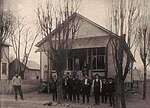Reduction, Pennsylvania
Company towns in PennsylvaniaUnincorporated communities in PennsylvaniaUnincorporated communities in Westmoreland County, PennsylvaniaUse mdy dates from July 2023Western Pennsylvania geography stubs
Reduction (also Flynns) is an unincorporated community in South Huntingdon Township, Westmoreland County, Pennsylvania. United States. The community is located on the Youghiogheny River. Its population is 60, down from a peak of 400.
Excerpt from the Wikipedia article Reduction, Pennsylvania (License: CC BY-SA 3.0, Authors).Reduction, Pennsylvania
Reduction Circle, South Huntingdon Township
Geographical coordinates (GPS) Address Nearby Places Show on map
Geographical coordinates (GPS)
| Latitude | Longitude |
|---|---|
| N 40.183611111111 ° | E -79.770833333333 ° |
Address
Reduction Circle 404
15479 South Huntingdon Township
Pennsylvania, United States
Open on Google Maps









